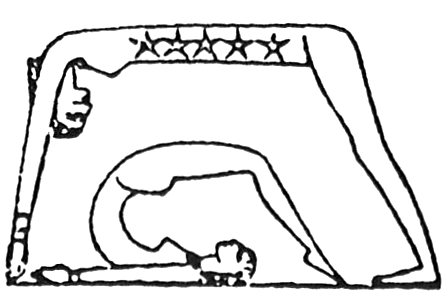
Sacred Texts Egypt Index Previous Next
Buy this Book at Amazon.com

Hieroglyphics of Horapollo, tr. Alexander Turner Cory, [1840], at sacred-texts.com
To denote a mother, or vision, or boundary, or foreknowledge, or a year, or heaven, or one that is compassionate, or Athena [Neith], or Hera [Saté], or two drachmas, they delineate it a mother, because in this race of creatures there is no male. Gignuntur autem hunc in modum. Cum amore concipiendi vultur exarserit, vulvam ad Boream aperiens, ab eo velut comprimitur per dies quinque, during which time
she partakes neither of food nor drink, being intent upon procreation. There are also other kinds of birds which conceive by the wind, but their eggs are of use only for food, and not for procreation; but the eggs of the vultures that are impregnated by the wind possess a vital principle. The vulture is used also as a symbol of vision, because it sees more keenly than all other creatures; and by looking towards the west when the sun is in the east, and towards the east when the god is in the west, it procures its necessary food from afar. And it signifies a boundary [landmark?] because, when a battle is to be fought, it points out the spot on which it will take place, by betaking itself thither seven days beforehand:—and foreknowledge, both from the circumstance last mentioned,
and because it looks towards that army which is about to have the greater number killed, and be defeated, reckoning on its food from their slain: and on this account the ancient kings were accustomed to send forth observers to ascertain towards which part of the battle the vultures were looking, to be thereby apprized which army was to be overcome. And it symbolizes a year, because the 365 days of the year, in which the annual period is completed, are exactly apportioned by the habits of this creature; for it remains pregnant 120 days, and during an equal number it brings up its young, and during the remaining 120 it gives its attention to itself, neither conceiving nor bringing up its young, but preparing
itself for another conception; 1 and the remaining five days of the year, as I have said before, it devotes to another impregnation by the wind. It symbolises also a compassionate person, which appears to some to be the furthest from its nature, inasmuch as it is a creature that preys upon all things; but they were induced to use it as a symbol for this, because in the 120 days, during which it brings up its offspring, it flies to no great distance, but is solely engaged about its young and their sustenance; and if during this period it should be without food to give its young, it opens its own thigh, and suffers its offspring to partake of the blood, that they may not perish from want of nourishment:—and Athena [Neith], and Hera [Saté], because
among the Egyptians Athena [ Neith] is regarded as presiding over the upper hemisphere, and Hera [Saté] over the lower; whence also they think it absurd to designate the heaven in the masculine, τὸν οὑρανὸν, but represent it in the feminine, τὴν οὑρανὸν, inasmuch as the generation of the sun and moon and the rest of the stars, is perfected in it, which is the peculiar property of a female. And the race of vultures, as I said before, is a race of females alone, and on this account the Egyptians over any female hieroglyph place the vulture as a mark of royalty [maternity?]. And hence, not to prolong my discourse by mentioning each individually, when the Egyptians would designate any goddess who is a mother, they delineate a vulture, for it is the mother of a female progeny. And they denote by it (οὑρανίαν)
heaven, (for it does not suit them to say τὸν οὑρανὸν, as I said before,) because its generation is from thence [by the wind]:—and two drachmas, because among the Egyptians the unit [of money] is the two drachmas, 1 and the unit is the origin of every number, therefore when they would denote two drachmas, they with good reason depict a vulture, inasmuch as like unity it seems to be mother and generation.

Netpe, as the upper hemisphere, or heaven; Isis, as the lower, or earth.
26:1 This division appears to intimate the three seasons of the Egyptian year,—four months of Vegetation, four months of Harvest, and four of the Inundation, and the five epagomenæ consecrated as the birthdays of the gods.
28:1 Par A. Treb. Leem.γραμμαί al.—Leemans observes that the Alexandrine Interpreters of the Old Testament always reckon the money by the didrachma, as in xxx. Ex. 13, for the drachma they use the half of a didrachma, τὸ ἡ?'μισυ τοῦ διδράχμου.